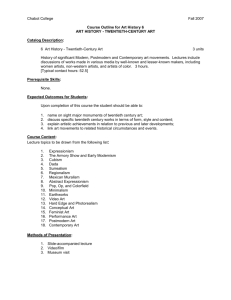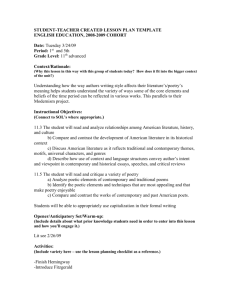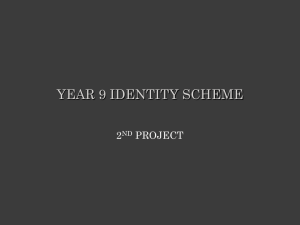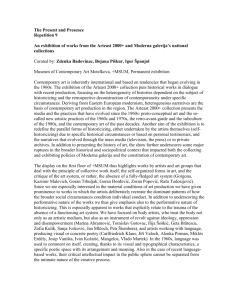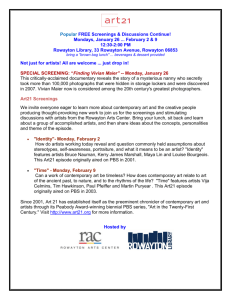Week12_Digital Media in Art
advertisement
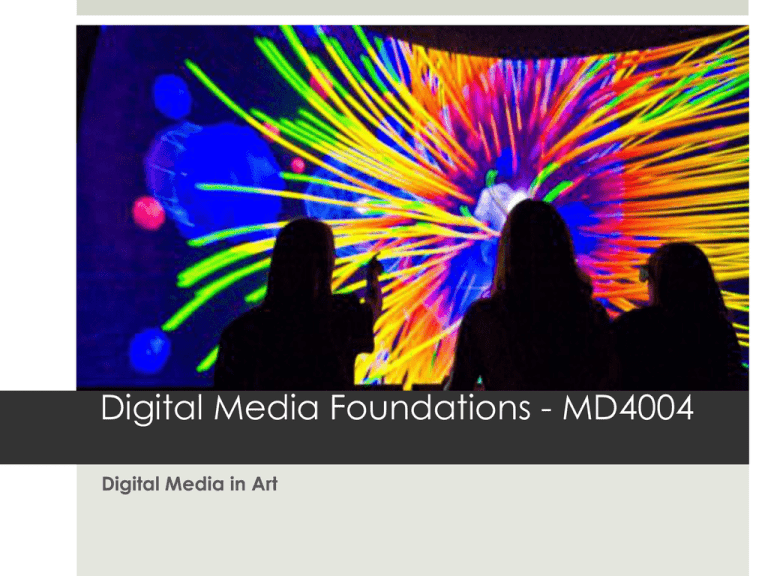
Digital Media Foundations - MD4004 Digital Media in Art why ART? Josiah McElheny, The Uniform Body (after Popova and Rodchenko), 2012 Josiah McElheny, The Constructivist Body (after Delaunay), 2012 Anish Kapoor, Svayambh at the Royal Academy of Arts, 2007 Michael Craig-Martin, An Oak Tree (1973). Rirkrit Tiravanija, Untitled (Free), 1992 The Context of Art Is the history of art, a history of works? Or a history of the circumstances shaping it? ‘Context is the web of complex circumstances in which artists work in relation to their physical environment, historical trends and traditions, social movements, cultural values, intellectual perspectives, personal commitments, and more. Likewise, art is received within a context of corresponding dynamics that shape meaning and interpretation. As such, context is an inescapable dimension of art in both its production and its reception and interpretation.' (Vander Lugt, 2011) Venus of Willendorf, circa 24,000–22,000 BC Cave painting of a horse from the Lascaux caves, c.16,000 BC Leonardo Da Vinci, anatomical sketch of a human skull, c. 1472 - 1519 Painting by Song Dynasty artist Ma Lin, c. 1250 Contemporary Art Western-centric logic (works illustrating/challenging sociocultural values and trends related to the west) Art in art’s Spaces (or challenging Art Institutions) Art by artists and for art audiences Art as distinct from crafts or technology Definitions of art by art’s theorists Art in reference to art-history, legacies, genres, styles Pre-modern Era: - Images/signs tied to social hierarchies - Renaissance: Transition of power from the Church to the Medici, return to Classical sources. - Artists as craftsmen supported by guilds, the church, the state, the rich and powerful The first art history book: Giorgio Vasari (1550) The Lives of the Most Excellent Painters, Sculptors, and Architects. The first public art gallery: Palazzo degli Uffizi in 1591 Leonardo da Vinci, Vitruvian Man, 1492 Rococo: Pair of lovers, c. 1760, by Franz Anton Bustelli Baroque: Bernini's Ecstasy of St. Teresa,1652 Neo-classicism Jacques-Louis David, Oath of the Horatii, 1784 Modernism Impressionism Monet, Impression, Sunrise, 1872 Impressionism Expressionism Fauvism Gauguin, Riders on the Beach, 1902 Cubism Dadaism Surrealism Max Ernst, The Elephant Celebes, 1921 Duchamp, Nude Descending a Staircase,1912 Modernism -Mass production, reproduction (no longer imitation of nature) http://www.youtube.com/watch?v=LnfB-pUm3eI Modernism and new definitions of Art Clement Greenberg "The essence of Modernism lies, as I see it, in the use of characteristic methods of a discipline to criticize the discipline itself” (Greenberg, 1961, p. 1) Separation between ‘high culture’ (ruling classes, beyond the surface) and ‘low culture’ (Kitsch, mechanically produced, operating by formulas, commercial) Mark Rothko, No. 61 (Rust and Blue), 1953 High art is the only hope for a better type of art Technology being a threat for high culture!! Pollock, Autumn Rhythm (Number 30), 1950 The decline of the Elite and rise of capitalism “The masses have always remained more or less indifferent to culture in the process of development. But today such culture is being abandoned by those to whom it actually belongs—our ruling class. For it is to the latter that the avantgarde belongs. […] And now this elite is rapidly shrinking. Since the avant-garde forms the only living culture we now have, the survival in the near future of culture in general is thus threatened.” (Greenberg, 1939, p. 38) “Another mass product of Western Industrialism, it has gone on a triumphal tour of the world, crowding out and defacing native cultures in one colonial county after another, so that it is now by way of becoming a universal culture, the first universal culture ever beheld” (Ibid., p. 39) Contemporary Art Western-centric context (illustrating/challenging socio-cultural values and trends related to the west) Art in art’s Spaces (or challenging Art Institutions) Art by artists and for art audiences Art as distinct from crafts or technology Definitions of art by art’s theorists Art in reference to art-history, legacies, genres, styles The classification of "contemporary art" as a special type of art, rather than a general adjectival phrase, goes back to the beginnings of Modernism Lyle Ashton Harris (2000) The Miss America Triptych. Robert Mapplethorpe (1980) Self-portrait. Laura Aguilar (1989) In Sandy’s Room. Adrian Piper (1974) I/You (Her). Digital Art Digital Art engages with digital technologies that confront us daily in the world – photography, film, video, text, book, electronic and digital technologies, installation, performance, screenings, sound works… - Digital versions of old Media (video, painting, sculpture, photography, sound art) - New Expressions (net.art, digital installations, virtual reality, fractal art) - Combinations that blur the boundaries and relationships between different media (multidisciplinarity, multimedia art, computer art). - Mass production and distribution net.art refers to a group of artists who worked in the medium of Internet art from 1994. E.g. Alexei Shulgin ‘Desktop Is’ (1997/1998) Fractal art (since the 80s) is a form of algorithmic art created by calculating fractal objects and representing the calculation results as still images, animations, and media. Fractal image generated by Electric Sheep (http://www.electricsheep.org/ ) Is the medium the message in art? ‘“Media art” is [...] such a problematic term […] a distinction from contemporary art is impossible to draw, since all art uses some sort of medium, and many modern and contemporary artworks have used media technologies without qualifying as “media art” in a narrower sense. It seems that, more than anything else, “media art” is a way of looking at works’. Andreas Broeckmann (2005) http://www.crumbweb.org/discItemDetail.php?&useArch=1&archID=2179&op=2&sublink=1&fromSearch= 1& ‘At first I thought I could simply draw a line under the word medium, bury it like so much critical toxic waste, and walk away from it into a world of lexical freedom. “Medium” seemed too contaminated, too ideologically, too dogmatically, too discursively loaded.’ Rosalind Krauss (1999) A Voyage on the North Sea ‘when Arts Electronica program asks “In which direction is artists’ work with the new instruments like algorithms and dynamic systems transforming the process of artistic creativity?” […], the very assumptions behind such a question put it outside of the paradigm of contemporary art». ‘And why the use of this term [new technologies] is often welcomed this way: “Every time you describe these artists by material, you are hurting, and not helping them”’ Brody Condon (2008) Lev Manovich (2003) ‘AF 2003’ Domenico Quaranta (2010) Media, New Media, Postmedia Art World Content galleries, art fairs, private, public and corporate collections objects ≠ Media Art World Medium festivals, symposia and meetings experiences http://medianewmediapostmedia.wordpress.com/english-abstract/ Christiane Paul on curating digital media (2008) ‘It is an art form that still hasn’t found an established place in the arts at large. Many people are still scared of computers, technology, and interfaces and do not understand the inherent possibilities of the medium. I could easily curate a show consisting of projects that I find very interesting, and it would turn out to be a complete “geekfest,” entirely inaccessible to a larger art audience.' http://umintermediai501.blogspot.co.uk/2008/05/intervie w-with-christiane-paul-sheila.html Camille Henrot, Grosse Fatigue, 2013 Chisenhale Gallery (London): 28 February – 13 April 2014 Preview: Thursday 27 February 2014, 6.30-8.30pm Venice Biennale Silver Lion 2013 http://www.youtube.com/watch?v=MYycsJz8vtc Elizabeth Price, Choir, 2012 Turner Prize 2012 http://www.bielefelder-kunstverein.de/en/exhibitions/subjectiveprojections/elizabeth-price.html Ed Atkins, Warm, Warm, Warm Spring Mouths, 2013 Jerwood Film and Video Umbrella Award 2013 http://vimeo.com/58420827 from 4:40 until the end Gerard Richter, Symphony of Light at Cologne Cathedral, 2007 Mariko Mori, Wave UFO, (2003) First digital media auction 2013 at Phillips http://online.wsj.com/news/articles/SB1 0001424052702304713704579091192929 676208 Claire Bishop in Artforum 2012 ‘the hybridized solutions that visual art is currently pursuing – analogue in appearance, digital in structure – seem always biased toward the former, so favored by the market. If the digital means anything for visual art, it is the need to take stock of this orientation and to question art’s most treasured assumptions. At its most utopian, the digital revolution opens up a new dematerialized, deauthored, and unmarketable reality of collective culture; at its worst, it signals the impending obsolescence of visual art itself. (Bishop, 2012, p. 4) Or just the integration of digital media in Art? Bibliography Berger, J. (1972) ‘Chapter 1’, Ways of Seeing. London: Penguin, London, pp. 7-34. Broeckmann, Andreas (2005) Discussing 'Media Art' by http://www.crumbweb.org/discItemDetail.php?&useArch=1&archID=2179&op=2&sublink=1&fromSearch=1 &16 Colson, R. The fundamentals of digital art “Chapter 1: The History and Development of Digital Art”. Clement Greenberg (1939) ‘Avant-Garde and Kitsch.’ [Online]. Available from:http://www.google.co.uk/url?sa=t&rct=j&q=&esrc=s&source=web&cd=2&ved=0CDMQFjAB&url=http% 3A%2F%2Fxroads.virginia.edu%2F~DRBR2%2Fgreenburg.pdf&ei=jVWoUsr0FYKGhQfLvoGACQ&usg=AFQjCNG LU2p9KsbWHWzQAMwUtQ3CdTO6gw&sig2=49ymdr4v1JAXJIWZtqFWwA [Last accessed: 11/12/2013] Greenberg, Clement (1961)’Modernist Painting’. [Online]. Available at: http://www.google.co.uk/url?sa=t&rct=j&q=&esrc=s&source=web&cd=2&ved=0CDUQFjAB&url=http%3A%2 F%2Fcas.uchicago.edu%2Fworkshops%2Fwittgenstein%2Ffiles%2F2007%2F10%2FGreenbergmodpaint.pdf&ei =KECoUs2xAsKUhQe0YDABA&usg=AFQjCNEGMg2GsUBC7sm_Do1deexIo2xlOA&sig2=XZ1ZQiNfCN0l5MUDK6RH1Q&bvm=bv.5779 9294,d.ZG4 [Last accessed: 11/12/2013] Bishop, C. (2012) ‘Digital Divide: Contemporary Art and New Media’. Artforum. [Online]. Available at: http://www.google.co.uk/url?sa=t&rct=j&q=&esrc=s&source=web&cd=1&ved=0CDIQFjAA&url=http%3A%2F %2Fleepatrickjohnson.files.wordpress.com%2F2012%2F09%2Fdigital-divide-contemporary-art-and-newmedia-artforum-com-by-claire-bishop-sept-2012.pdf&ei=EHoUvCTAcSu7AaV5ICYBQ&usg=AFQjCNEN4UKudfx1SNhljmoFa0ziV4yOWA&sig2=oRyiaPou8fjb26DWddi6Pw& bvm=bv.57799294,d.ZGU [Last accessed: 11/12/2013] Vander Lugt, W. (2011) 'The Context of Art’, Transpositions. [Online]. Available at: http://www.transpositions.co.uk/2011/04/the-context-of-art/ . [Last accessed 10/12/2013] Quaranta, Domenico (2010) Media, New Media, Postmedia http://medianewmediapostmedia.wordpress.com/english-abstract/ Happy Christmas Break!!!
